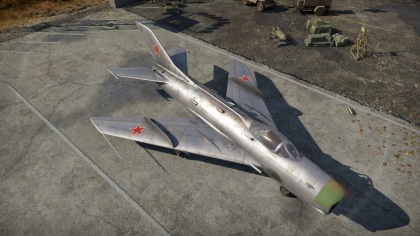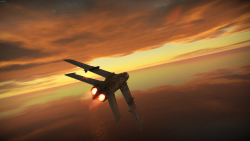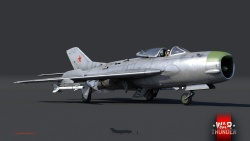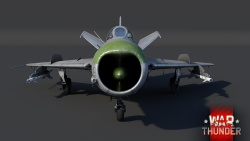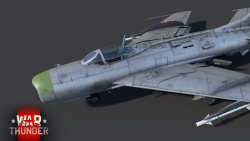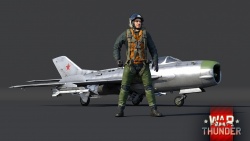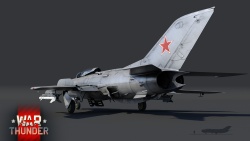Difference between revisions of "MiG-19PT"
(Updated armarment section as the R-13M is no longer avaliable) (Tag: Visual edit) |
(Edits) |
||
| Line 9: | Line 9: | ||
<!-- ''In the description, the first part should be about the history of and the creation and combat usage of the aircraft, as well as its key features. In the second part, tell the reader about the aircraft in the game. Insert a screenshot of the vehicle, so that if the novice player does not remember the vehicle by name, he will immediately understand what kind of vehicle the article is talking about.'' --> | <!-- ''In the description, the first part should be about the history of and the creation and combat usage of the aircraft, as well as its key features. In the second part, tell the reader about the aircraft in the game. Insert a screenshot of the vehicle, so that if the novice player does not remember the vehicle by name, he will immediately understand what kind of vehicle the article is talking about.'' --> | ||
[[File:GarageImage_{{PAGENAME}}.jpg|420px|thumb|left]] | [[File:GarageImage_{{PAGENAME}}.jpg|420px|thumb|left]] | ||
| − | {{ | + | {{Break}} |
| − | The '''{{Specs|name}}''' is a rank {{Specs|rank}} | + | The '''{{Specs|name}}''' is a rank {{Specs|rank}} Soviet jet fighter {{Battle-rating}}. It was introduced in [[Update 1.85 "Supersonic"]] and was one of the first three jets to feature guided air-to-air missiles, the other two being the [[F-100D]] and the [[Javelin F.(A.W.) Mk.9]]. |
== General info == | == General info == | ||
| Line 22: | Line 22: | ||
! rowspan="2" | Characteristics | ! rowspan="2" | Characteristics | ||
! colspan="2" | Max Speed<br>(km/h at 10,000 m) | ! colspan="2" | Max Speed<br>(km/h at 10,000 m) | ||
| − | ! rowspan="2" | Max altitude<br>( | + | ! rowspan="2" | Max altitude<br>(metres) |
! colspan="2" | Turn time<br>(seconds) | ! colspan="2" | Turn time<br>(seconds) | ||
| − | ! colspan="2" | Rate of climb<br>( | + | ! colspan="2" | Rate of climb<br>(metres/second) |
| − | ! rowspan="2" | Take-off run<br>( | + | ! rowspan="2" | Take-off run<br>(metres) |
|- | |- | ||
! AB !! RB !! AB !! RB !! AB !! RB | ! AB !! RB !! AB !! RB !! AB !! RB | ||
| Line 33: | Line 33: | ||
|- | |- | ||
! Upgraded | ! Upgraded | ||
| − | | | + | | ___ || 1,436 || __._ || 32.0 || __._ || 180.0 |
|- | |- | ||
|} | |} | ||
| Line 42: | Line 42: | ||
! colspan="6" | Features | ! colspan="6" | Features | ||
|- | |- | ||
| − | ! Combat flaps !! Take-off flaps !! Landing flaps !! Air brakes !! Arrestor gear !! | + | ! Combat flaps !! Take-off flaps !! Landing flaps !! Air brakes !! Arrestor gear !! Drogue chute |
|- | |- | ||
| X || ✓ || ✓ || ✓ || X || ✓ <!-- ✓ --> | | X || ✓ || ✓ || ✓ || X || ✓ <!-- ✓ --> | ||
| Line 118: | Line 118: | ||
The '''''{{PAGENAME}}''''' is armed with: | The '''''{{PAGENAME}}''''' is armed with: | ||
| − | |||
* 2 x 30 mm NR-30 cannons, wing-mounted (70 rpg = 140 total) | * 2 x 30 mm NR-30 cannons, wing-mounted (70 rpg = 140 total) | ||
| Line 127: | Line 126: | ||
=== Suspended armament === | === Suspended armament === | ||
<!-- ''Describe the aircraft's suspended armament: additional cannons under the wings, bombs, rockets and torpedoes. This section is especially important for bombers and attackers. If there is no suspended weaponry remove this subsection.'' --> | <!-- ''Describe the aircraft's suspended armament: additional cannons under the wings, bombs, rockets and torpedoes. This section is especially important for bombers and attackers. If there is no suspended weaponry remove this subsection.'' --> | ||
| − | {{main|OFAB-100 (100 kg)|OFAB-250-270 (250 kg)|R-3S | + | {{main|OFAB-100 (100 kg)|OFAB-250-270 (250 kg)|R-3S|S-5K}} |
The '''''{{PAGENAME}}''''' can be outfitted with the following ordnance: | The '''''{{PAGENAME}}''''' can be outfitted with the following ordnance: | ||
| + | * Without load | ||
| + | * 2 x R-3S missiles | ||
| + | * 2 x 100 kg OFAB-100 bombs (200 kg total) | ||
| + | * 2 x 250 kg OFAB-250-270 bombs (500 kg total) | ||
| + | * 16 x S-5K rockets | ||
| + | * 32 x S-5K rockets | ||
| − | + | The MiG-19PT can carry two R-3S air to air missiles on under-wing pylons. The missiles have a 10G overload with 8.8 kg TNT explosive equivalent. They travel at a speed of 1,000 m/s which is average for air to air missiles. The ideal use-case for the missiles is when you're at very high speed, following something like a Phantom from around a mile. The missile will get to the target before they can react, and with large targets like the Phantom, they can't pull hard enough at those speeds to evade the missile. It is not recommended to fire the missile in any sort of turn as they will just lose track. | |
| − | |||
| − | |||
| − | |||
| − | |||
| − | |||
| − | |||
| − | |||
== Usage in battles == | == Usage in battles == | ||
| − | <!--''Describe the tactics of playing in the aircraft, the features of using aircraft in a team and advice on tactics. Refrain from creating a "guide" - do not impose a single point of view, but instead, give the reader food for thought. Examine the most dangerous enemies and give recommendations on fighting them. If necessary, note the specifics of the game in different modes (AB, RB, SB).''--> | + | <!-- ''Describe the tactics of playing in the aircraft, the features of using aircraft in a team and advice on tactics. Refrain from creating a "guide" - do not impose a single point of view, but instead, give the reader food for thought. Examine the most dangerous enemies and give recommendations on fighting them. If necessary, note the specifics of the game in different modes (AB, RB, SB).'' --> |
| − | + | The MiG-19PT has great vertical energy retention and acceleration, so you should use this to your advantage. Taking the enemies vertical is the best move as they will quickly lose energy while you can maintain it. Once at high speed, the MiG-19PT will out-accelerate almost all other aircraft, so once you're on the tail of an enemy they will not have many options. The airbrake is also a very effective tool, allowing you to stay behind someone if they try to force you to overshoot and the plane also rolls well enough that you can engage in rolling scissors if need be. | |
| − | The MiG-19PT has great vertical energy retention and acceleration, so you should use this to your advantage. Taking the enemies vertical is the best move as they will quickly lose energy while you can maintain it. Once at high speed, the MiG-19PT will out-accelerate almost all other aircraft, so once you're on the tail of an enemy they will not have many options. The airbrake is also a very effective tool, allowing you to stay behind someone if they try to force you to overshoot and the plane also rolls well enough that you can engage in rolling scissors if need be. | ||
It is recommended to avoid throttling down the engine as it has an extremely long spool time until it produces max thrust and this will let your opponent get away from you while you struggle to accelerate. | It is recommended to avoid throttling down the engine as it has an extremely long spool time until it produces max thrust and this will let your opponent get away from you while you struggle to accelerate. | ||
| Line 151: | Line 148: | ||
The MiG-19PT is equipped with a [[RP-5]] search and tracking radar. One radar antenna is located in the centre of the air intake, while the other (and the main body of the radar) is located in the nose of the aircraft, above the intake. | The MiG-19PT is equipped with a [[RP-5]] search and tracking radar. One radar antenna is located in the centre of the air intake, while the other (and the main body of the radar) is located in the nose of the aircraft, above the intake. | ||
| + | |||
{| class="wikitable" style="text-align:center" | {| class="wikitable" style="text-align:center" | ||
! colspan="4" | [[RP-5]] - Target Detection Radar | ! colspan="4" | [[RP-5]] - Target Detection Radar | ||
| Line 209: | Line 207: | ||
| | | | ||
| | | | ||
| − | | | + | | |
|- | |- | ||
|} | |} | ||
| Line 217: | Line 215: | ||
'''Pros:''' | '''Pros:''' | ||
| − | |||
* Higher top speed possible than [[F-100D]] above 6,500 m | * Higher top speed possible than [[F-100D]] above 6,500 m | ||
* Incredibly high rate of climb | * Incredibly high rate of climb | ||
| Line 228: | Line 225: | ||
'''Cons:''' | '''Cons:''' | ||
| − | |||
* Compression at high speed, wings don't provide as much lift as the Super Sabre | * Compression at high speed, wings don't provide as much lift as the Super Sabre | ||
* Wings can rip when rolling and turning at high speed | * Wings can rip when rolling and turning at high speed | ||
| Line 239: | Line 235: | ||
== History == | == History == | ||
<!-- ''Describe the history of the creation and combat usage of the aircraft in more detail than in the introduction. If the historical reference turns out to be too long, take it to a separate article, taking a link to the article about the vehicle and adding a block "/History" (example: <nowiki>https://wiki.warthunder.com/(Vehicle-name)/History</nowiki>) and add a link to it here using the <code>main</code> template. Be sure to reference text and sources by using <code><nowiki><ref></ref></nowiki></code>, as well as adding them at the end of the article with <code><nowiki><references /></nowiki></code>. This section may also include the vehicle's dev blog entry (if applicable) and the in-game encyclopedia description (under <code><nowiki>=== In-game description ===</nowiki></code>, also if applicable).'' --> | <!-- ''Describe the history of the creation and combat usage of the aircraft in more detail than in the introduction. If the historical reference turns out to be too long, take it to a separate article, taking a link to the article about the vehicle and adding a block "/History" (example: <nowiki>https://wiki.warthunder.com/(Vehicle-name)/History</nowiki>) and add a link to it here using the <code>main</code> template. Be sure to reference text and sources by using <code><nowiki><ref></ref></nowiki></code>, as well as adding them at the end of the article with <code><nowiki><references /></nowiki></code>. This section may also include the vehicle's dev blog entry (if applicable) and the in-game encyclopedia description (under <code><nowiki>=== In-game description ===</nowiki></code>, also if applicable).'' --> | ||
| − | |||
After taking its first flight in 1954, the MiG-19 became a worldwide sensation – it was the first mass-produced aircraft capable of breaking the sound barrier in horizontal flight after taking off from the ground. Although it was the most advanced combat aircraft of its day, the MiG-19 also had certain problems with maneuverability, and certain other improvements also took shape that were then used in the upgraded versions of the MiG-19. The fighter received an all-movable stabilizer that significantly improved its flight characteristics, enhanced control and braking systems, and new, more powerful 30mm guns instead of 23mm guns. One of the most interesting modifications was the MiG-19PT fighter-interceptor, which was developed especially for the installation of K-13 (P-3C) air-to-air missiles. This missile was strongly influenced by the extremely successful American Sidewinder, models of which the Soviet Union received from China. The MiG-19PT's flight tests were successfully completed in 1964. The K-13 missile was then used on an entire series of combat aircraft and remained in active use until the end of the 80s. The MiG-19 itself was modernized several times and participated in many armed conflicts. Over 2,000 MiG-19s were manufactured in the USSR, and even more MiGs were manufactured in China: over 4,500 units. | After taking its first flight in 1954, the MiG-19 became a worldwide sensation – it was the first mass-produced aircraft capable of breaking the sound barrier in horizontal flight after taking off from the ground. Although it was the most advanced combat aircraft of its day, the MiG-19 also had certain problems with maneuverability, and certain other improvements also took shape that were then used in the upgraded versions of the MiG-19. The fighter received an all-movable stabilizer that significantly improved its flight characteristics, enhanced control and braking systems, and new, more powerful 30mm guns instead of 23mm guns. One of the most interesting modifications was the MiG-19PT fighter-interceptor, which was developed especially for the installation of K-13 (P-3C) air-to-air missiles. This missile was strongly influenced by the extremely successful American Sidewinder, models of which the Soviet Union received from China. The MiG-19PT's flight tests were successfully completed in 1964. The K-13 missile was then used on an entire series of combat aircraft and remained in active use until the end of the 80s. The MiG-19 itself was modernized several times and participated in many armed conflicts. Over 2,000 MiG-19s were manufactured in the USSR, and even more MiGs were manufactured in China: over 4,500 units. | ||
| − | ''- From [ | + | ''- From [[wt:en/news/5934-development-mig-19pt-target-locked-en|Devblog]]'' |
== Media == | == Media == | ||
| − | <!--Excellent additions to the article would be video guides, screenshots from the game, and photos.--> | + | <!-- ''Excellent additions to the article would be video guides, screenshots from the game, and photos.'' --> |
| − | |||
;Images | ;Images | ||
<div><ul> | <div><ul> | ||
| Line 260: | Line 254: | ||
;Videos | ;Videos | ||
| − | |||
{{Youtube-gallery|gfGoEp0HbZc|'''The Shooting Range #137''' - ''Metal Beasts'' section at 00:35 discusses the MiG-19PT.}} | {{Youtube-gallery|gfGoEp0HbZc|'''The Shooting Range #137''' - ''Metal Beasts'' section at 00:35 discusses the MiG-19PT.}} | ||
== See also == | == See also == | ||
''Links to the articles on the War Thunder Wiki that you think will be useful for the reader, for example:'' | ''Links to the articles on the War Thunder Wiki that you think will be useful for the reader, for example:'' | ||
| − | |||
* ''reference to the series of the aircraft;'' | * ''reference to the series of the aircraft;'' | ||
* ''links to approximate analogues of other nations and research trees.'' | * ''links to approximate analogues of other nations and research trees.'' | ||
| Line 274: | Line 266: | ||
* ''encyclopedia page on the aircraft;'' | * ''encyclopedia page on the aircraft;'' | ||
* ''other literature.'' --> | * ''other literature.'' --> | ||
| − | + | * [[wt:en/news/5934-development-mig-19pt-target-locked-en|[Devblog] MiG-19PT: Target Locked]] | |
| − | * [ | ||
{{AirManufacturer MiG}} | {{AirManufacturer MiG}} | ||
{{USSR jet aircraft}} | {{USSR jet aircraft}} | ||
Revision as of 13:05, 29 March 2020
Contents
| This page is about the Russian jet fighter MiG-19PT. For other versions, see MiG-19 (Family). |
Description
The MiG-19PT is a rank Soviet jet fighter
with a battle rating of (AB), (RB), and (SB). It was introduced in Update 1.85 "Supersonic" and was one of the first three jets to feature guided air-to-air missiles, the other two being the F-100D and the Javelin F.(A.W.) Mk.9.
General info
Flight performance
Compression at high speeds is an issue for this aircraft. It especially affects the rudder. However, the MiG-19PT generally has a very responsive elevator, although excessive turning will bleed much speed due to the poor energy retention. As with many jets, manoeuvrability is poor at low speeds.
The aircraft has very good acceleration and climb rate.
| Characteristics | Max Speed (km/h at 10,000 m) |
Max altitude (metres) |
Turn time (seconds) |
Rate of climb (metres/second) |
Take-off run (metres) | |||
|---|---|---|---|---|---|---|---|---|
| AB | RB | AB | RB | AB | RB | |||
| Stock | 1,426 | 1,421 | 32.4 | 33.0 | 160.0 | 149.2 | 500 | |
| Upgraded | ___ | 1,436 | __._ | 32.0 | __._ | 180.0 | ||
Details
| Features | |||||
|---|---|---|---|---|---|
| Combat flaps | Take-off flaps | Landing flaps | Air brakes | Arrestor gear | Drogue chute |
| X | ✓ | ✓ | ✓ | X | ✓ |
| Limits | ||||||
|---|---|---|---|---|---|---|
| Wings (km/h) | Gear (km/h) | Flaps (km/h) | Max Static G | |||
| Combat | Take-off | Landing | + | - | ||
| N/A | 500 | 450 | ~11 | ~5 | ||
| Optimal velocities (km/h) | |||
|---|---|---|---|
| Ailerons | Rudder | Elevators | Radiator |
| < 540 | < 650 | < 350 | N/A |
Engine performance
| Engine | Aircraft mass | |||||
|---|---|---|---|---|---|---|
| Engine name | Number | Empty mass | Wing loading (full fuel) | |||
| Mikulin RD-9B | 2 | 5,447 kg | 301 kg/m2 | |||
| Engine characteristics | Mass with fuel (no weapons load) | Max Takeoff Weight | ||||
| Weight (each) | Type | 7m fuel | 20m fuel | 23m fuel | ||
| 725 kg | Afterburning axial-flow turbojet | 6,311 kg | 7,328 kg | 7,563 kg | 9,100 kg | |
| Maximum engine thrust @ 0 m (RB / SB) | Thrust to weight ratio @ 0 m (WEP) | |||||
| Condition | 100% | WEP | 7m fuel | 20m fuel | 23m fuel | MTOW |
| Stationary | 2,296 kgf | 3,215 kgf | 1.02 | 0.88 | 0.85 | 0.71 |
| Optimal | 2,320 kgf (1,000 km/h) |
3,248 kgf (1,000 km/h) |
1.03 | 0.89 | 0.86 | 0.71 |
Survivability and armour
The aircraft is fairly fragile, with any hits likely to damage the engines due to how much space they take up inside the plane. When spaded one engine has enough power to get you back to base, but while stock it is a little harder and you may end up crashing. One benefit of the MiG though is that the elevators are separate to each other in the damage model, and therefore a hit to the tail causing an elevator loss isn't the end of the world, since the remaining one is good enough to continue the fight. Another point to note is that loss of oil in either engine will rapidly cause engine failure, so it is best to return to base ASAP when damaged.
Armaments
Offensive armament
The MiG-19PT is armed with:
- 2 x 30 mm NR-30 cannons, wing-mounted (70 rpg = 140 total)
The MiG-19 carries two 30 mm NR-30 cannons, mounted in the wing roots. Each gun has 70 rounds of ammunition, making a total of 140 rounds. The NR-30 cannons are very fast firing so this is not much ammo, and you can't afford to spray. The guns however are extremely powerful, and only a couple of rounds hitting an enemy aircraft will severely cripple them, if not outright kill them. The shell velocity is very high and you don't need much lead to hit a target.
The recommended belts for this aircraft are Ground Targets, they're more reliable than the Air Target belts and tend to take off wings and large sections, and destroy engines with one hit, in comparison to the air target belts which tend to spark or just damage external modules. The ground belts contain APHE rounds with 60 mm of penetration, but it is not really worth going for ground targets as the limited ammunition and high speed of the aircraft makes it very difficult to hit or kill anything.
Suspended armament
The MiG-19PT can be outfitted with the following ordnance:
- Without load
- 2 x R-3S missiles
- 2 x 100 kg OFAB-100 bombs (200 kg total)
- 2 x 250 kg OFAB-250-270 bombs (500 kg total)
- 16 x S-5K rockets
- 32 x S-5K rockets
The MiG-19PT can carry two R-3S air to air missiles on under-wing pylons. The missiles have a 10G overload with 8.8 kg TNT explosive equivalent. They travel at a speed of 1,000 m/s which is average for air to air missiles. The ideal use-case for the missiles is when you're at very high speed, following something like a Phantom from around a mile. The missile will get to the target before they can react, and with large targets like the Phantom, they can't pull hard enough at those speeds to evade the missile. It is not recommended to fire the missile in any sort of turn as they will just lose track.
Usage in battles
The MiG-19PT has great vertical energy retention and acceleration, so you should use this to your advantage. Taking the enemies vertical is the best move as they will quickly lose energy while you can maintain it. Once at high speed, the MiG-19PT will out-accelerate almost all other aircraft, so once you're on the tail of an enemy they will not have many options. The airbrake is also a very effective tool, allowing you to stay behind someone if they try to force you to overshoot and the plane also rolls well enough that you can engage in rolling scissors if need be.
It is recommended to avoid throttling down the engine as it has an extremely long spool time until it produces max thrust and this will let your opponent get away from you while you struggle to accelerate.
Radars
The MiG-19PT is equipped with a RP-5 search and tracking radar. One radar antenna is located in the centre of the air intake, while the other (and the main body of the radar) is located in the nose of the aircraft, above the intake.
| RP-5 - Target Detection Radar | |||
|---|---|---|---|
| Maximum Detection Range |
Guaranteed Detection Range |
Max Azimuth Scan Angle |
Max Elevation Scan Angle |
| 12,000 m | 8,000 m | ±60° | ±40° |
| RP-5 - Target Tracking Radar | |||
| Maximum Tracking Range |
Minimum Tracking Range |
Azimuth Tracking Angle |
Elevation Tracking Angle |
| 4,500 m | 100 m | ±7° | ±7° |
Modules
| Tier | Flight performance | Survivability | Weaponry | |||
|---|---|---|---|---|---|---|
| I | Fuselage repair | Compressor | Offensive 30 mm | FAB-100 | ||
| II | New boosters | Airframe | FAB-250 | R-3S | ||
| III | Wings repair | New 30 mm cannons | S5K | |||
| IV | G-suit | Engine | Cover | |||
Pros and cons
Pros:
- Higher top speed possible than F-100D above 6,500 m
- Incredibly high rate of climb
- Hard-hitting guns, low recoil effects due to wing root placement
- Great vertical energy retention
- Roll rate superior to the MiG-17
- Incredible acceleration from 600-900 km/h, so it is able to regain energy very fast
- Has a target detection and tracking radar
- Decent manoeuvrability
Cons:
- Compression at high speed, wings don't provide as much lift as the Super Sabre
- Wings can rip when rolling and turning at high speed
- Only two air-to-air missiles, locking range is 0.5 km less than that of the AIM-9B on F-100D
- Poor low-speed manoeuvrability
- Ventral fin will impact the ground during takeoff if the rotation is prematurely initiated resulting in the tail breaking off
- Engines are huge; can be easily disabled by enemy fire
- Radar suite is not as good as the one fitted on the Javelin F.(A.W.) Mk.9 and Mitsubishi T-2
History
After taking its first flight in 1954, the MiG-19 became a worldwide sensation – it was the first mass-produced aircraft capable of breaking the sound barrier in horizontal flight after taking off from the ground. Although it was the most advanced combat aircraft of its day, the MiG-19 also had certain problems with maneuverability, and certain other improvements also took shape that were then used in the upgraded versions of the MiG-19. The fighter received an all-movable stabilizer that significantly improved its flight characteristics, enhanced control and braking systems, and new, more powerful 30mm guns instead of 23mm guns. One of the most interesting modifications was the MiG-19PT fighter-interceptor, which was developed especially for the installation of K-13 (P-3C) air-to-air missiles. This missile was strongly influenced by the extremely successful American Sidewinder, models of which the Soviet Union received from China. The MiG-19PT's flight tests were successfully completed in 1964. The K-13 missile was then used on an entire series of combat aircraft and remained in active use until the end of the 80s. The MiG-19 itself was modernized several times and participated in many armed conflicts. Over 2,000 MiG-19s were manufactured in the USSR, and even more MiGs were manufactured in China: over 4,500 units.
- From Devblog
Media
- Images
- Videos
See also
Links to the articles on the War Thunder Wiki that you think will be useful for the reader, for example:
- reference to the series of the aircraft;
- links to approximate analogues of other nations and research trees.
External links
| Mikoyan-Gurevich Design Bureau (Микоя́н и Гуре́вич Опытное конструкторское бюро) | |
|---|---|
| Fighters | MiG-3-15 · MiG-3-15 (BK) · MiG-3-34 |
| I-225 | |
| Jet fighters | MiG-9 · MiG-9 (l) |
| MiG-15 · MiG-15bis · MiG-15bis ISh | |
| MiG-17 | |
| MiG-19PT | |
| MiG-21F-13 · MiG-21PFM · MiG-21S (R-13-300) · MiG-21SMT · MiG-21bis | |
| MiG-23M · MiG-23ML · MiG-23MLD | |
| MiG-27M · MiG-27K | |
| MiG-29 · MiG-29SMT | |
| Export/Licensed | ␗MiG-9 · ␗MiG-9 (l) |
| ◊MiG-15bis · ◔MiG-15bis · J-2* | |
| MiG-17AS · ◔MiG-17PF · J-4* · Shenyang F-5* | |
| ◊MiG-19S · J-6A* | |
| ◄MiG-21 SPS-K · ◊MiG-21MF · ◔MiG-21MF · ▄MiG-21bis · ◔MiG-21bis-SAU · ◊MiG-21bis-SAU · ◊MiG-21 "Lazur-M" · ▄MiG-21 Bison · J-7II** | |
| ◊MiG-23BN · ◊MiG-23MF · ◔MiG-23MF · ◊MiG-23MLA | |
| ◔MiG-29 · ◊MiG-29 · ◄MiG-29G | |
| *Licensed and domesticated with Chinese designations. | |
| **Unlicensed, reverse-engineered and domesticated with Chinese designations. | |
| See Also | Shenyang · Chengdu |
| USSR jet aircraft | |
|---|---|
| Bereznyak-Isayev | BI |
| Yakovlev | Yak-15 · Yak-15P · Yak-17 · Yak-23 · Yak-28B · Yak-30D · Yak-38 · Yak-38M · Yak-141 |
| Mikoyan-Gurevich | MiG-9 · MiG-9 (l) · MiG-15 · MiG-15bis · MiG-15bis ISh · MiG-17 · MiG-17AS · MiG-19PT |
| MiG-21F-13 · MiG-21PFM · MiG-21S (R-13-300) · MiG-21SMT · MiG-21bis | |
| MiG-23M · MiG-23ML · MiG-23MLD · MiG-27M · MiG-27K | |
| MiG-29 · MiG-29SMT | |
| Lavochkin | La-174 · La-15 · La-200 |
| Sukhoi | Su-9 · Su-11 |
| Su-7B · Su-7BKL · Su-7BMK · Su-17M2 · Su-17M4 · Su-22M3 | |
| Su-24M | |
| Su-25 · Su-25BM · Su-25K · Su-25T · Su-25SM3 · Su-39 | |
| Su-27 · Su-27SM | |
| Su-34 | |
| Ilyushin | IL-28 · IL-28Sh |
| Tupolev | Tu-14T |



